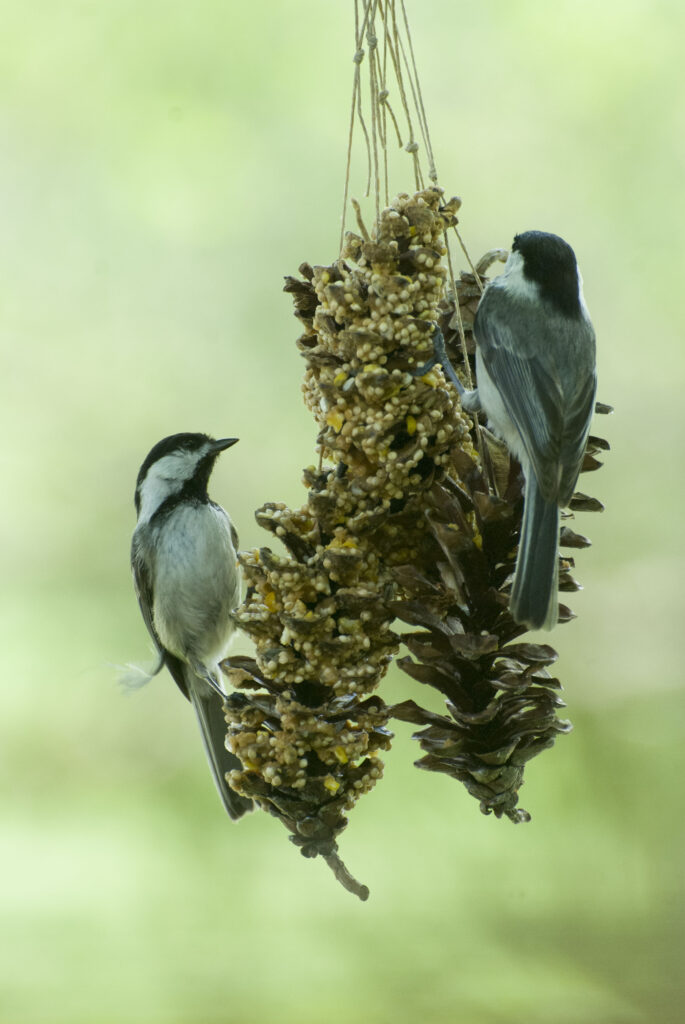Watching birds visit your backyard bird feeder can make at-home days more entertaining.
But what if you don’t have a bird feeder? They can be expensive to buy, and avoiding entering stores for non-essentials may be an extra deterrent for many.
Cost and coronavirus don’t have to stop us from giving food to backyard birds. There are many DIY options — including some which are great activities to do with children of all ages.

For a super quick and easy bird feeder, and one that children will have a blast making, you only need a few simple supplies:
-large pinecones
-peanut butter
-birdseed
-string
Tie the string around the end of the pinecone(s), and secure it with a knot. It’s easiest if you tie it so that when it hangs, the bottom of the cone is up. Make a loop at the other end of the string to hang the cone from.
Scoop out a spoonful or two of peanut butter into a small dish. Using a teaspoon or table knife, cover the pinecone with peanut butter, including along the inside of the scales.
Pour birdseed into a dish, and roll the peanut butter-covered cone in the seeds. Scoop and sprinkle seeds onto any area that still shows bare peanut butter.
Hang one or multiple cones in your yard for birds to enjoy. A spot near trees and shrubs will be more likely to attract birds, as those give them a safe harbor to dart into if they sense danger (such as hawks and other predators).
If you have hung the feeder in a likely area, but birds aren’t eating from it, try hanging a few empty cones with the seeded cones. The bare cones give the birds a place to perch, as they peck at those coated with peanut butter and seeds.
This is a low maintenance bird feeding option. Keep an eye out for mold (and remove cones immediately if you see any), and simply toss the cones into the compost when they are empty or old.
If you don’t have pinecones available, coat the outside of a toilet paper roll with peanut butter and seed, and thread a string through the middle to hang it from.
You can make refillable bird feeders from many materials; glass or plastic bottles, terra cotta pots, wood, or even ceramic dishes.

To make a bird feeder with a couple old plates, you will need:
-two saucers (sub a larger plate for one if you’d like)
-plastic pipe
-metal mesh
-rope
-hot glue and hot glue gun
-drill with a drill bit for concrete or glass
Drill a hole in the center of your two plates or saucers. Fold your wire mesh in half leaving an inch at the bottom of a single layer — this keeps the seeds from falling through except at the bottom. Join the two ends of the folded mesh together to create a cylinder (tucking one end inside the fold of the other can help secure it).
Cut the plastic pipe to the same height as the metal cylinder. Using hot glue, secure the pipe to the plate over the drilled hole.
Bend the mesh at two or three points along the bottom — this will allow the seed to fall out onto the plate. Then secure the mesh to the plate with hot glue at a few spots.
Tie a large and secure knot at the end of your rope. Thread the rope through the plate, pipe and through the second saucer. Tie a loop at the top of the rope, a few inches above the top plate — this will give you room to lift the plate to refill the feeder.
Pour birdseed inside the mesh, and hang the feeder outside. Nearby, add a bowl of water held with a little macrame to give your neighborhood birds a clean place to drink after their snack.
When choosing seed to use in homemade (or bought) feeders, consider what birds you want to attract, and more importantly what birds are in your yard.
Sunflower seeds may bring chickadees, house finches, titmice, jays, grosbeaks, cardinals, sparrows, nuthatches, woodpeckers, doves, and goldfinches.
Nyjer seeds — smaller and pricier — are enjoyed by purple finches, redpolls, pine siskins, and quail. Doves, sparrows, juncos, quail, buntings and wild turkeys like millet. Cardinals, nuthatches, jays, woodpeckers and house finches eat safflower seeds.
Experts disagree on whether we should put out food for birds — some say it causes unnatural mingling of species, which can cause diseases to spread, but others support feeding wild birds, saying it can help attract them to your area, where they will also eat and control insect populations.
To keep wild birds safe while they enjoy your DIY feeders, be sure to keep water and feeders clean. Don’t put out or leave out spoiled seed, and clean up seed if it falls to the ground and piles up. Change hummingbird nectar regularly, so it doesn’t grow bacteria, which can make birds sick.
Try making multiple types of feeders with different feeds, to see which your neighborhood birds prefer, and spend some of your safer-at-home time enjoying watching birds use your handiwork.
By Aldona Bird
Tweet @DominionPostWV
"bird" - Google News
May 31, 2020 at 02:55AM
https://ift.tt/3gCA1uV
DIY bird feeders are wallet-friendly and summer fun for the whole family - Dominion Post - The Dominion Post
"bird" - Google News
https://ift.tt/2s1zYEq
https://ift.tt/3dbExxU
Bagikan Berita Ini














0 Response to "DIY bird feeders are wallet-friendly and summer fun for the whole family - Dominion Post - The Dominion Post"
Post a Comment